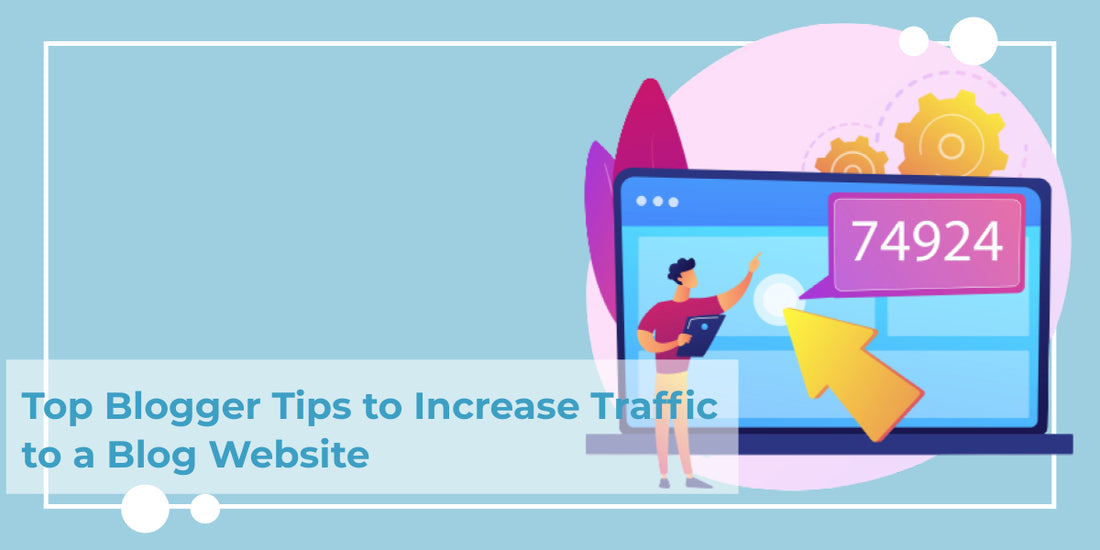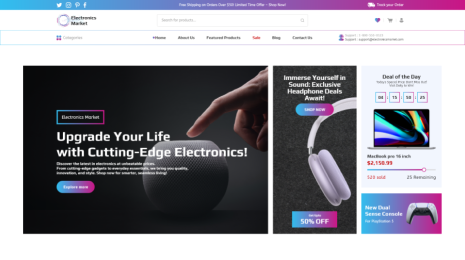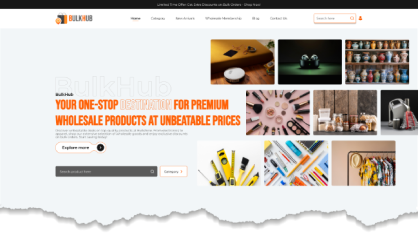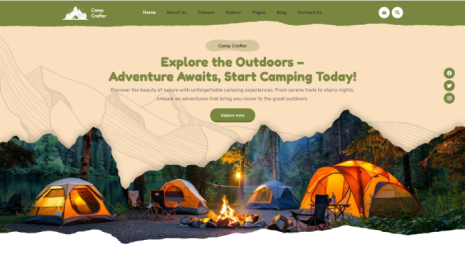
Traffic is the lifeblood of any blogging or business website that greatly impact online presence and help to reach a larger audience. There are many strategies you can implement to increase more traffic to your blog.
Some of the most effective methods include publishing depth content, drafting clickable titles, social media shares, sending newsletter, optimizing internal linking, creating shareable images, collaborating with influencers in your niche.
In this article, you will learn about the most effective ways to increase traffic on your blog. So, let's get started.
Top Blogger Tips to Increase Traffic to Blog Website
By consistently implementing these tactics and experimenting with new methods, you can continue to grow your blog's traffic and reach your desired audience.
1. Create and Publish In-Depth Content
Creating and publishing in-depth content regularly is the most critical step to increasing traffic on your blog. The more unique, high-quality content you produce, the more likely readers will be interested in reading your blog.
You should strive to create original, informative and entertaining but simple pieces of writing that will engage your audience. Make sure that all of your articles are well-researched before posting them. This is important to check so that you can back up any claims made with facts or statistics from reputable sources.
Make sure everything is clear from start to finish by including plenty of images throughout each post. Break sentences into shorter paragraphs with headers/headings that make sense based on context.
It's best if you post a blog at least once weekly as you can have regular visitors. So, make sure there's always something new on yours. However, don't overload yourself with work by trying too hard; just do what feels natural.
2. Craft Clickable Post Titles
You need to use short and clickable post titles for your blogs. You also want to ensure that the title is catchy and relevant to the content of your post. Here are some guidelines to craft short and catchy post titles.
Power words: Use power words in your post titles because they can help grab attention from potential readers. For example, suppose you're writing about how to achieve success with blogging. In that case, use words like "guide," "step-by-step", or even "proven methods."
Numbers: Numbers are another way of drawing attention of visitors. This is a great way because people love number-based titles. This makes sense because it offers an immediate direction on what kind of information, they're going to learn from reading this article. Plus, who doesn't love learning new things?
Questions: Asking questions in titles works well, too. This is because it gives people something else to think about beyond just facts or figures. Instead, they'll be curious enough about what answers lie behind those queries, so they'll click through.
3. Optimize for Search Engines
Use your most important keyword(s) at the start of each post title, in the sub-heading and within the opening paragraph. Make sure you also use them evenly throughout the blog post content, so it's not just focused on one particular word or phrase.
This will help search engines understand what kind of content is on offer here. This even makes it easier for users to find what they're looking for when they search for those terms online.
Create an author attribution: You should include an author attribution at the bottom of every blog post so that it's clear who wrote it. People lover to read from the authorized and expertise sources. Including writers bio at the last of blog post helps to increase EAT score that helps to boost your SERP rankings.
Create a sitemap: This essential part of SEO helps search engines understand what's on offer within your blog. It should include all the pages you want to appear in search results and their URLs.
Use Light Theme: Bulky templates takes time to load, deteriorate user experience, hence google outrank slow loading websites. Instead using light and premium WordPress themes will load fast will help to gain SERP ranking.
4. Share Content on Social-Media
Social media platforms like Facebook, Twitter and LinkedIn are a great way to increase traffic to your blog. You can use these platforms to share your content with people who may not have found you otherwise.
When sharing content on social media channels, ensure you're linking directly to the original post on your site. Don't just post a link or picture with no context. This will help ensure that readers can easily find more information if they want.
If you want more traffic from social media, you should also consider building a presence on platforms like Instagram and Pinterest. These sites tend to attract a different audience than Facebook or Twitter and can be valuable tools for driving traffic to your blog.
One of the best ways to get more traffic from social media platforms is by creating content that people want to share.
Try using images, videos or info graphics whenever possible these types of content tend to perform well on social media channels.
Include social sharing buttons on the post so that, if any readers found your informative they can share your content on their social profiles.
5. Send Newsletter to Subscribers
Email newsletters are an excellent way to build your audience and communicate with your subscribers.
The first step is to build an email list so that you have a list of people who have signed up for your newsletter. You can do this using the opt-in form at the bottom of each post on your blog or by offering something free in exchange for their email address.
Once you have a sizable number of subscribers, sending out regular newsletters will help keep them engaged with what's going on in your industry or niche area.
6. Guest Post on Popular Blogs in Your Industry
Guest posting is a great way to get your content in front of new audiences. You can use guest posts to build relationships with other bloggers, build your brand and authority, and even grow your email list.
Writing for other blogs in your industry allows you to promote yourself without seeming like a self-promoter. This is because the host site will be promoting it too. The host site will also share their audience with you through links back to their site.
Many people hesitate to write guest posts because they're unsure how to approach it or don’t want to be seen as a self-promoter. We know the feeling. But you should try it, especially if you’re struggling to grow your blog audience.
Writing for other blogs is also an excellent way for new bloggers to build their brand and authority in their industry without starting from scratch with their site.
7. Collaborating with Influencers
Collaborating with influencers is a proven method to drive more traffic to a blog website. An influencer is a person with a large following on social media platforms who has the power to sway opinions and drive actions. By collaborating with influencers, bloggers can tap into their audience and reach a new, larger audience.
Here are some benefits of collaborating with influencers that can help drive more traffic to a blogging website:
Increased Exposure: Influencers have a large following on social media platforms such as Instagram, Twitter, and Facebook. By collaborating with influencers, bloggers can reach their followers and gain exposure to a new audience.
Increased Engagement: Influencers are known for creating engaging content that resonates with their followers. By partnering with influencers, bloggers can create engaging content that their followers will be more likely to share, comment on, and like.
Social Media Sharing: Influencers are often active on social media and will likely share their content with their followers. This can help to drive more traffic to the blogger's website.
Increased Visibility: Influencers are often featured in articles, interviews, and other media outlets. By partnering with influencers, bloggers can increase their visibility and reach a wider audience.
Increased Credibility: Collaborating with influencers can increase the credibility of a blog website. Influencers are trusted sources of information and their followers are likely to trust their opinions and recommendations.
8. Comment on Others' Blog Posts
Commenting on others' posts is another great way to get your name out there. Commenting on other blogs and social media posts will show people that you're an active member of the community.
This will also portray that you are interested in what they have to say. You can also leave comments on your blog. But make sure they are relevant or else the site's moderators may delete them.
Also, this method can be beneficial when someone has left an insightful comment that sparks further discussion about something specific within an article.
8. Incorporate Outbound Links
Incorporating outbound links is effective way of driving more traffic to the blog. Firstly, outbound links act as a referral system where readers are redirected to other relevant and authoritative sources, providing them with a broader perspective on the topic.
This encourages them to return to the blog to explore other topics and keep them engaged. Secondly, linking to other sites helps establish the blog as a credible source, demonstrating the writer’s research and knowledge on the subject.
This can result in the blog being shared or linked back to, increasing its visibility and attracting more visitors.
Lastly, outbound links can also improve the search engine ranking of the blog, as search engines favor sites that provide relevant and valuable information to their users.
9. Use Internal Linking
Internal linking is the practice of linking to your content. This will help with your website search engine optimization (SEO) and make it easier for people to find what they're looking for on your site.
It's vital to link within the same page. But you can also link between related pages to draw attention back up the content hierarchy on your blog or website. For example, suppose you have an article about "10 Ways to Eat Healthy" and then mention another article on eating healthy desserts later in that same post. In that case, you might want to link back up through your navigation bar so readers can quickly get there.
There are tons of ways to do this, from using anchor text to linking directly to a page or article. But the best way is to try it out and see what works best for you.
It's important to note that you don’t want to overdo it with your linking. If you link every single word, it can come across as spammy and leave a bad taste in the mouth of your readers. Instead, try to only link specific keywords or phrases that are important for your article and make sense within the context of the content.
You can also use links to help boost the SEO of your website. By linking to other sites that are relevant to yours, you can help Google determine what your site is about and how it should be ranked. This is especially important if you're trying to rank for a keyword or phrase that doesn't have much competition.
10. Create Shareable Images
Images are an essential part of any blog post. They can help you increase traffic and engagement and make your content more shareable on social media. A great image will catch readers' eye.
But it's also essential to make sure that you're using relevant images that aren't too busy or distracting from your text. When creating images for your blog posts, here are some tips:
Use Topic Match Images: Suppose you have written about gardening tips for beginners. In that case, include photos of gardens in bloom or just one single flower blooming out of its pot. These types of images will reinforce what readers already know about gardening while also encouraging them to learn more about how they can grow their flowers at home.
Visually Appealing: If possible, try not only to use photos taken by professional photographers; sometimes amateur shots work just as well. Just make sure they look nice.
Remember: High quality + well edited = good engagement.
Avoid Overdo: Try to use only a few images in one post. Too many pictures can make your blog look unprofessional and cluttered. If you include more than one image, try to make them all relevant to each other and the topic.
Correct Dimensions: If you include a photo or image taken by someone else, make sure it's at least 1200px wide. This will ensure that your readers can see your images' intricate details.
Image Captions: Captions are super crucial for sharing your blog posts on social media because they allow people to understand what your photos are about. They can also help you gain more followers by encouraging readers to click through and read more of your content.
11. Use Website Analytics and Improve
Use your website analysis stats to rectify mistakes and optimize your blog to reach wider audience. Google Analytics is a tool that helps you to track your website traffic. It's a free service that you can use to see how many people are visiting your blog, from where they're coming from, and which pages they're viewing most often.
This information will help you pinpoint which areas need improvement so that you can focus on creating content that converts well into traffic.
Google Webmaster Tools is another free tool provided by Google that allows you to see how your website performing in search engine results (S.E.R.P.s). It also provides valuable insights about how many backlinks are pointing at each page of your site.
This also let you know what keywords do people type into search engines when searching for something related to what you write about on your blog. This info wisely will help to improve and lead more organic traffic towards your blog.
12. Update and Republish Old Content
If your blog is old and has a lot of content, you can use it as a traffic source by updating and republishing some of your old posts.
This is an effective strategy because people who have visited the page will see that post and may click on it again. This way, you are getting new traffic and increasing engagement with existing readers.
Don’t just republish everything, go through all your posts, search for trending topic posts you had already published. While doing so you will be able to shortlist the blog posts those topics have decent searches on search engines.
You will need to understand what actual info the present readers are exactly seeking for. You can add new info, delete some unfit portion and optimize it for present search trend. Updating and up ranking can drive more traffic to your old blog posts those were lying down low in SERP.
Conclusion
In conclusion, there are various methods that can be implement to increase traffic to a blog. Writing good content regularly, SEO optimization, drafting catchy post titles, influencer affiliation, sharing content on social media are some of the effective blog traffic tactics we have learned in this article.
Along with this you can do your blog web traffic analysis, and improve aspects of it where it lacking behind. Implementing a combination of these strategies to drive more traffic to your blog and reach a wider audience.
FAQ’s on How to Increase Traffic to Blog
What Do You Mean By Blog Traffic?
Blog traffic is the number of visitors arriving in a specific amount of time such as in an hour, a day or a week. The terms “blog visibility” and “blog traffic” are somehow synonymous.
Why Do You Require Drive Blog Traffic?
The digital world is vast. You may get lost if you are unable to drive potential traffic to your website or blog. The blog traffic guarantees you to bring ample of profits. It generates leads on your website. You can keep your website alive by bringing visitors and making them engage in your pages and posts.
It doesn’t matter whether you are advertising your personal blog, company business, running a marketplace or anything.









